Mineral Geochemistry of Basaltic Rocks from IODP Expeditions 334 and 344: Implications for Magmatic Processes of Cocos Ridge Segment Being Subducted Beneath the Middle America Trench
Abstract
:1. Introduction
2. Geological Setting and Sample Description
3. Methods
4. Results
4.1. Plagioclase
4.1.1. Major Elements
4.1.2. Trace Elements
4.2. Clinopyroxene
4.2.1. Major Elements
4.2.2. Trace Elements
5. Discussion
5.1. Source Lithology and the Degree of Partial Melting
5.2. Fractional Crystallization and Its Physical Conditions
5.2.1. Mineral Crystallization
5.2.2. Physical Conditions of Crystallization
Crystallization Temperatures and Pressures of Plagioclases
Crystallization Temperatures and Pressures of Clinopyroxenes
6. Conclusions
Supplementary Materials
Author Contributions
Funding
Institutional Review Board Statement
Informed Consent Statement
Data Availability Statement
Acknowledgments
Conflicts of Interest
References
- Morgan, W.J. Convection plumes in the lower mantle. Nature 1971, 230, 42–43. [Google Scholar] [CrossRef]
- Werner, R.; Hoernle, K.; Paul, V.; Ranero, C.; Von Huene, R.; Korich, D. Drowned 14-m.y.-old Galápagos archipelago off the coast of Costa Rica: Implications for tectonic and evolutionary models. Geology 1999, 27, 499–502. [Google Scholar] [CrossRef]
- Huene, R.V.; Ranero, C.R.; Weinrebe, W.; Hinz, K. Quaternary convergent margin tectonics of Costa Rica, segmentation of the Cocos Plate, and Central American volcanism. Tectonics 2000, 19, 314–334. [Google Scholar] [CrossRef] [Green Version]
- Walther, C. The crustal structure of the Cocos ridge off Costa Rica. J. Geophys. Res. Solid Earth 2003, 108, 2136. [Google Scholar] [CrossRef]
- Geist, D.J.; White, W.; McBirney, A. Plume-asthenosphere mixing beneath the Galapagos archipelago. Nature 1988, 333, 657–660. [Google Scholar] [CrossRef]
- White, W.; McBirney, A.; Duncan, R. Petrology and geochemistry of the Galápagos Islands: Portrait of a pathological mantle plume. J. Geophys. Res. Solid Earth 1993, 98, 19533–19563. [Google Scholar] [CrossRef]
- Blichert-Toft, J.; White, W.M. Hf isotope geochemistry of the Galapagos Islands. Geochem. Geophys. Geosyst. 2001, 2. [Google Scholar] [CrossRef]
- Harpp, K.S.; White, W.M. Tracing a mantle plume: Isotopic and trace element variations of Galápagos seamounts. Geochem. Geophys. Geosyst. 2001, 2. [Google Scholar] [CrossRef]
- Hoernle, K.; Werner, R.; Phipps Morgan, J.; Garbeschönberg, D.; Bryce, J.; Mrazek, J. Existence of complex spatial zonation in the Galápagos plume. Geology 2000, 28, 435–438. [Google Scholar] [CrossRef]
- Gibson, S.A.; Geist, D. Geochemical and geophysical estimates of lithospheric thickness variation beneath Galápagos. Earth Planet. Sci. Lett. 2010, 300, 275–286. [Google Scholar] [CrossRef]
- Harpp, K.S.; Weis, D. Insights into the origins and compositions of mantle plumes: A comparison of Galápagos and Hawaii. Geochem. Geophys. Geosyst. 2020, 21. [Google Scholar] [CrossRef]
- Herzberg, C.; Gazel, E. Petrological evidence for secular cooling in mantle plumes. Nature 2009, 458, 619–622. [Google Scholar] [CrossRef] [PubMed]
- Johnston, S.; Thorkelson, D. Cocos-Nazca slab window beneath Central America. Earth Planet. Sci. Lett. 1997, 146, 465–474. [Google Scholar] [CrossRef]
- Werner, R.; Hoernle, K.; Barckhausen, U.; Hauff, F. Geodynamic evolution of the Galápagos hot spot system (Central East Pacific) over the past 20 m.y.: Constraints from morphology, geochemistry, and magnetic anomalies. Geochem. Geophys. Geosyst. 2003, 4, 1108. [Google Scholar] [CrossRef]
- Harpp, K.; Wanless, V.; Otto, R.; Hoernle, K.; Werner, R. The Cocos and Carnegie Aseismic Ridges: A trace element record of long-term plume–spreading center interaction. J. Petrol. 2005, 46, 109–133. [Google Scholar] [CrossRef] [Green Version]
- Gazel, E.; Trela, J.; Bizimis, M.; Sobolev, A.; Batanova, V.; Class, C.; Jicha, B. Long-lived source heterogeneities in the Galapagos Mantle Plume. Geochem. Geophys. Geosyst. 2018, 19, 2764–2779. [Google Scholar] [CrossRef]
- Trela, J.; Vidito, C.; Gazel, E.; Herzberg, C.; Class, C.; Whalen, W.; Jicha, B.; Bizimis, M.; Alvarado, G. Recycled crust in the Galápagos Plume source at 70 Ma: Implications for plume evolution. Earth Planet. Sci. Lett. 2015, 425, 268–277. [Google Scholar] [CrossRef] [Green Version]
- Yan, Q.; Shi, X. Data report: Major and trace element and Sr-Nd-Pb isotope analyses for basement rocks from the CRISP-A transect drilled during expeditions 334 and 344. Proceedings of the Integrated Ocean Drilling Program, College Station, TX (Integrated Ocean Drilling Program). 2016. Available online: http://publications.iodp.org/proceedings/344/344toc.htm#Expedition_research_results (accessed on 15 March 2020).
- Vannucchi, P.; Ujiie, K.; Stroncik, N.; Malinverno, A. Expedition 334 Scientists. Proceedings of the IODP, 334: Tokyo (Integrated Ocean Drilling Program Anagement International, Inc.). 2012. Available online: http://publications.iodp.org/proceedings/334/334toc.htm#Expedition_research_results (accessed on 15 March 2020). [CrossRef]
- Harris, R.N.; Sakaguchi, A.; Petronotis, K. Input Site U1381. Proceedings of the Integrated Ocean Drilling Program, College Station, TX (Integrated Ocean Drilling Program). Harris, R.N., Sakaguchi, A., Petronotis, K., The Expedition 344 Scientists, Eds.; 2013. Available online: http://publications.iodp.org/proceedings/344/103/103_.htm (accessed on 15 March 2020).
- Harris, R.N.; Sakaguchi, A.; Petronotis, K. Proceedings of the Integrated Ocean Drilling Program, College Station, TX (Integrated Ocean Drilling Program). 2013. Available online: http://publications.iodp.org/proceedings/344/344toc.htm#Expedition_research_results (accessed on 15 March 2020).
- Brandstätter, J.; Kurz, W.; Richoz, S.; Cooper, M.; Teagle, D. The Origin of Carbonate Veins within the Sedimentary Cover and Igneous Rocks of the Cocos Ridge: Results from IODP Hole U1414A. Geochem. Geophys. Geosyst. 2018, 19, 3721–3738. [Google Scholar] [CrossRef]
- Li, Y.; Zhao, X.; Jovane, L.; Petronotis, K.; Gong, Z.; Xie, S. Paleomagnetic constraints on the tectonic evolution of the Costa Rican subduction zone: New results from sedimentary successions of IODP drill sites from the Cocos Ridge. Geochem. Geophys. Geosyst. 2015, 16, 4479–4493. [Google Scholar] [CrossRef] [Green Version]
- Sun, S.; McDonough, W. Chemical and isotopic systematics of oceanic basalts: Implications for mantle composition and processes. Geol. Soc. Lond. Spec. Publ. 1989, 42, 313–345. [Google Scholar] [CrossRef]
- Morimoto, N. Nomenclature of pyroxenes. Am. Mineral. 1988, 73, 1123–1133. [Google Scholar]
- Bédard, J. Parameterizations of calcic clinopyroxene-Melt trace element partition coefficients. Geochem. Geophys. Geosyst. 2014, 15, 303–336. [Google Scholar] [CrossRef]
- Hart, S.; Dunn, T. Experimental cpx/melt partitioning of 24 trace elements. Contrib. Mineral. Petrol. 1993, 113, 1–8. [Google Scholar] [CrossRef]
- Wang, X.; Li, Z.; Li, X.; Li, J.; Liu, Y.; Long, W.; Zhou, J.; Wang, F. Temperature, Pressure, and Composition of the Mantle Source Region of Late Cenozoic Basalts in Hainan Island, SE Asia: A Consequence of a Young Thermal Mantle Plume close to Subduction Zones? J. Petrol. 2012, 53, 177–233. [Google Scholar] [CrossRef]
- Danyushevsky, L.; Plechov, P. Petrolog3: Integrated software for modeling crystallization processes. Geochem. Geophys. Geosyst. 2011, 12, Q07021. [Google Scholar] [CrossRef]
- Mathez, E. Refinement of the Kudo-Weill plagioclase thermometer and its application to basaltic rocks. Contrib. Mineral. Petrol. 1973, 41, 61–72. [Google Scholar] [CrossRef]
- Putirka, K.D. Igneous thermometers and barometers based on plagioclase + liquid equilibria: Tests of some existing models and new calibrations. Am. Mineral. 2005, 90, 336–346. [Google Scholar] [CrossRef]
- Sun, C.; Liang, Y. A REE-in-plagioclase–clinopyroxene thermometer for crustal rocks. Contrib. Mineral. Petrol. 2017, 172. [Google Scholar] [CrossRef]
- Putirka, K.; Johnson, M.; Kinzler, R.; Longhi, J.; Walker, D. Thermobarometry of mafic igneous rocks based on clinopyroxene-liquid equilibria, 0–30 kbar. Contrib. Mineral. Petrol. 1996, 123, 92–108. [Google Scholar] [CrossRef]
- Putirka, K. Thermometers and Barometers for Volcanic Systems. Rev. Mineral. Geochem. 2008, 69, 61–120. [Google Scholar] [CrossRef]
- Woodland, A.; Jugo, P. A complex magmatic system beneath the Devès volcanic field, Massif Central, France: Evidence from clinopyroxene megacrysts. Contrib. Mineral. Petrol. 2007, 153, 719–731. [Google Scholar] [CrossRef]
- Dixon, J.; Leist, L.; Langmuir, C.; Schilling, J. Recycled dehydrated lithosphere observed in plume-influenced mid-ocean-ridge basalt. Nature 2002, 420, 385–389. [Google Scholar] [CrossRef] [PubMed]
- Stock, M.; Bagnardi, M.; Neave, D.; Maclennan, J.; Bernard, B.; Buisman, I.; Gleeson, M.; Geist, D. Integrated Petrological and Geophysical Constraints on Magma System Architecture in the Western Galapagos Archipelago: Insights from Wolf Volcano. Geochem. Geophys. Geosyst. 2018, 19, 4722–4743. [Google Scholar] [CrossRef]
- Winpenny, B.; Maclennan, J. A partial record of mixing of mantle melts preserved in Icelandic phenocrysts. J. Petrol. 2011, 52, 1791–1812. [Google Scholar] [CrossRef] [Green Version]
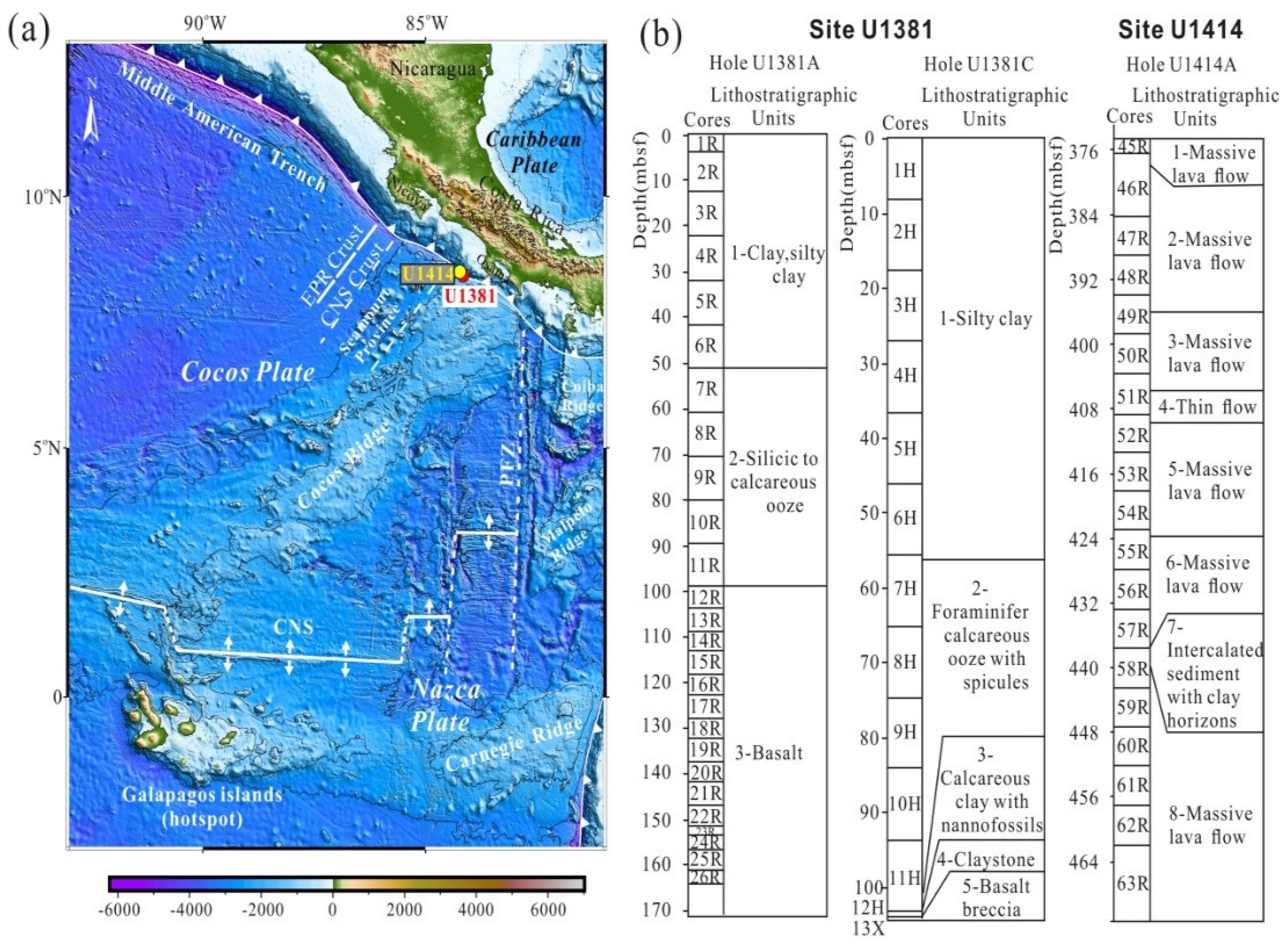
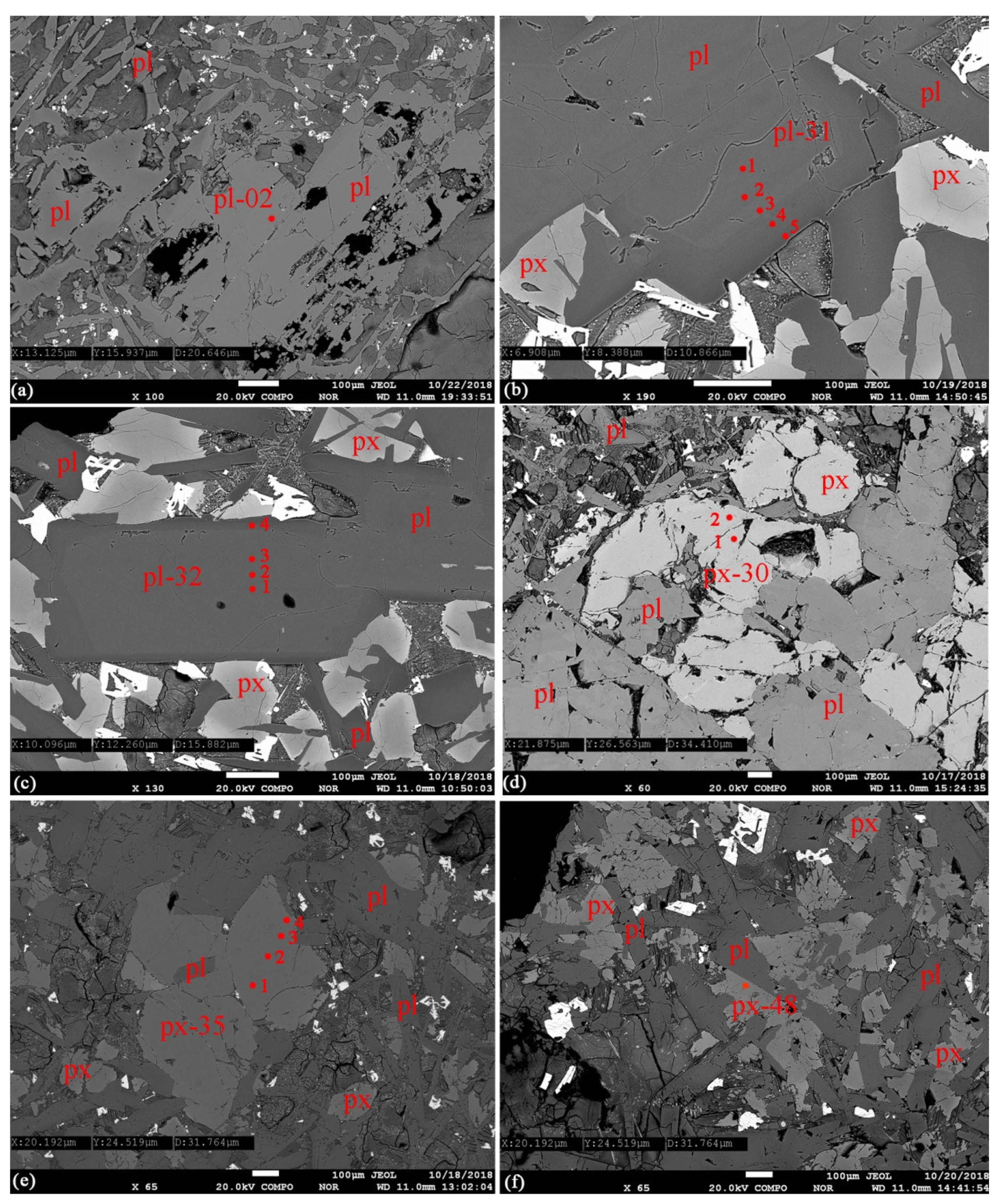
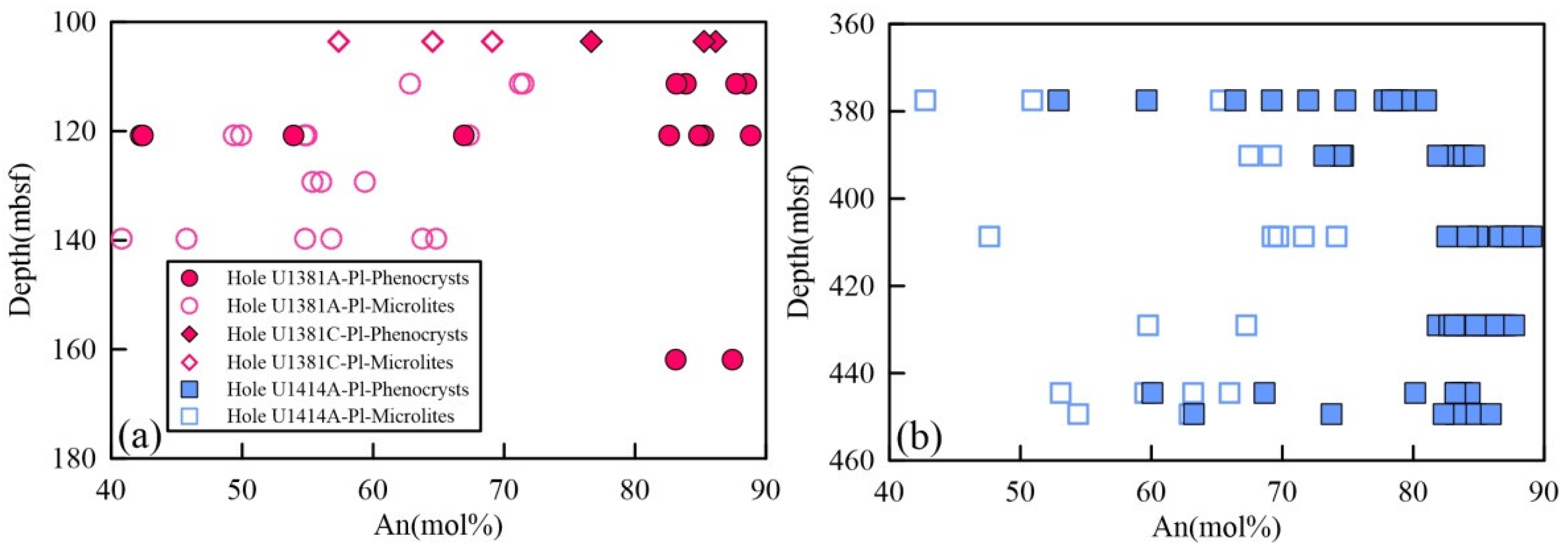


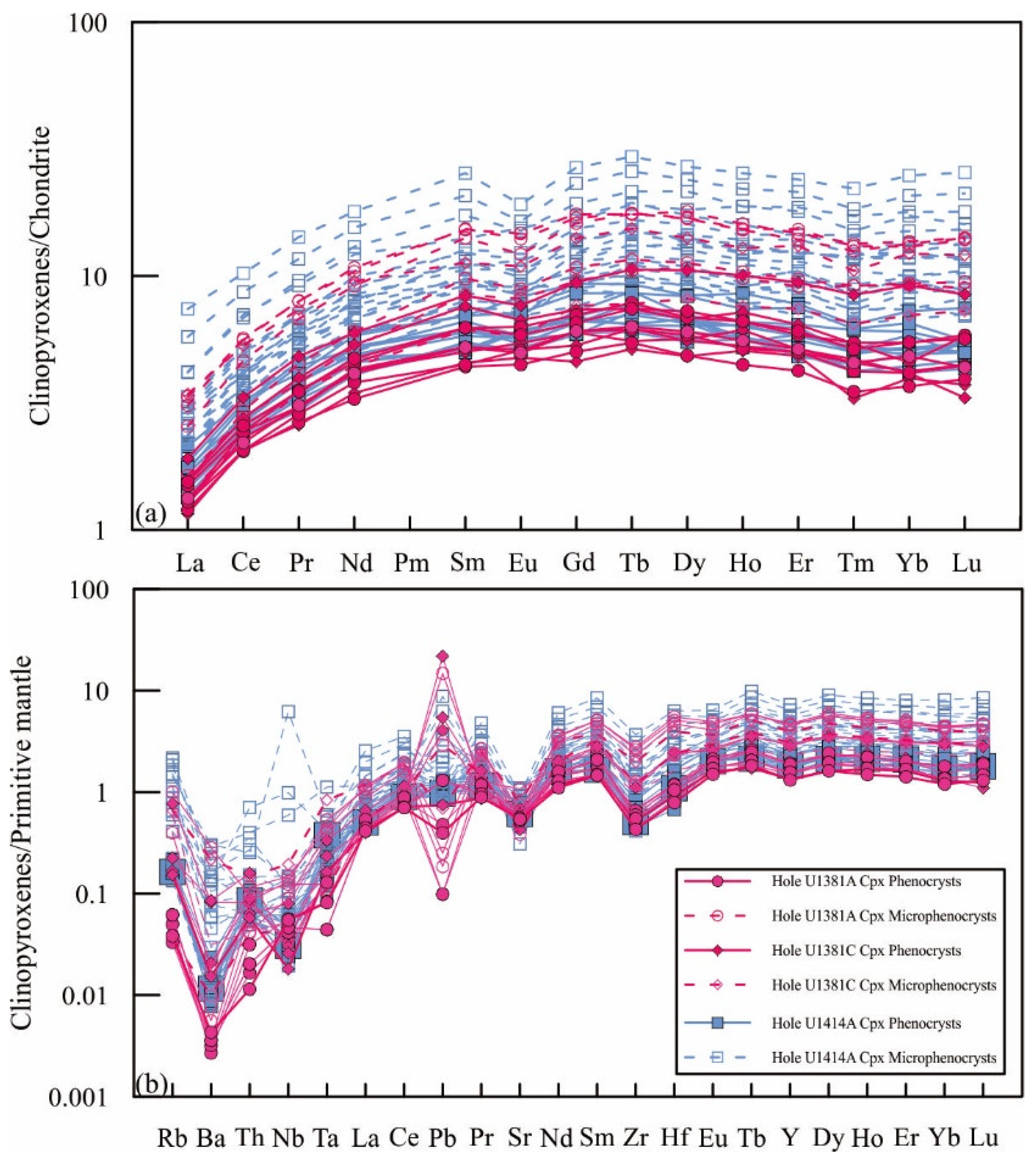

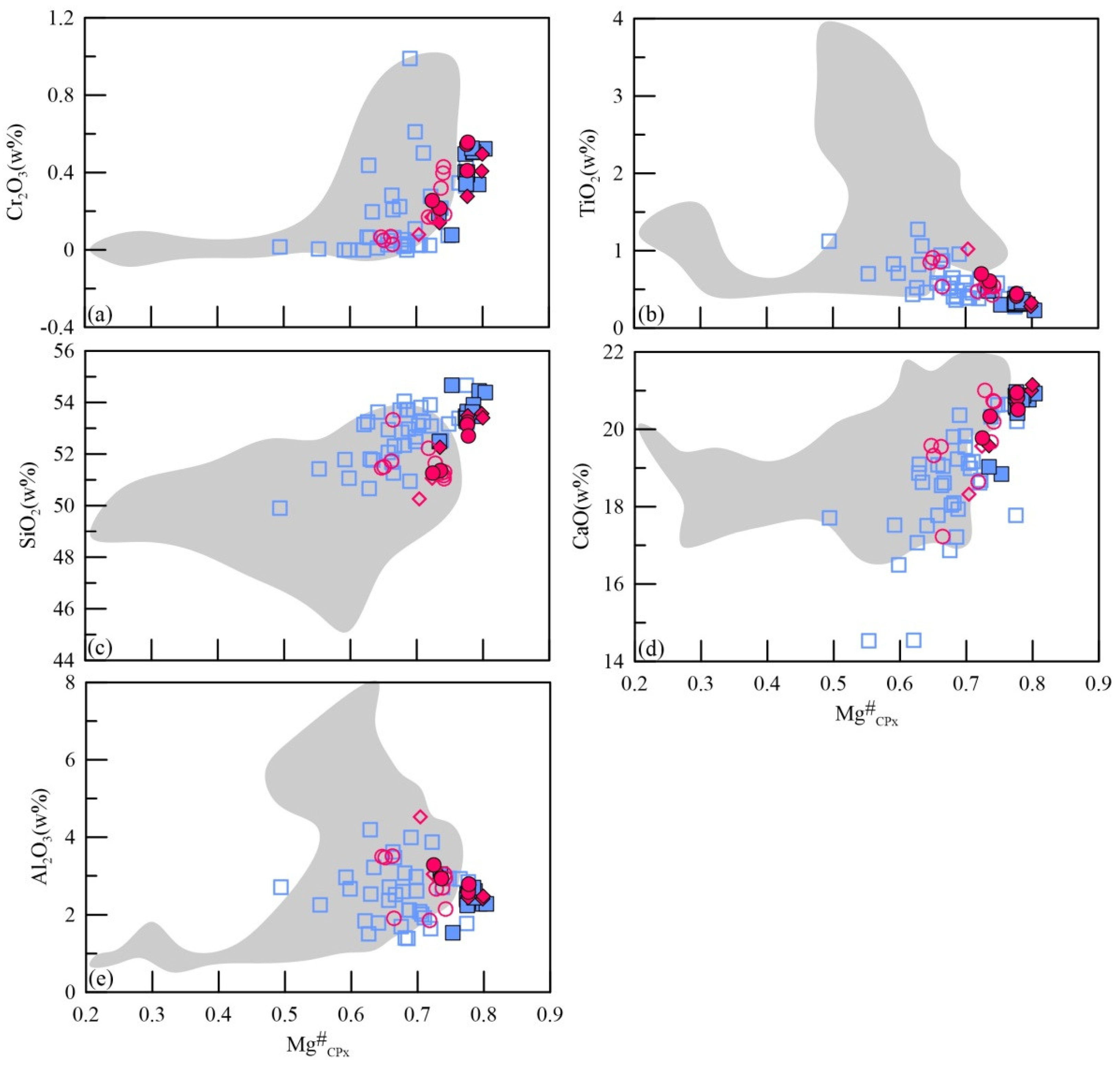

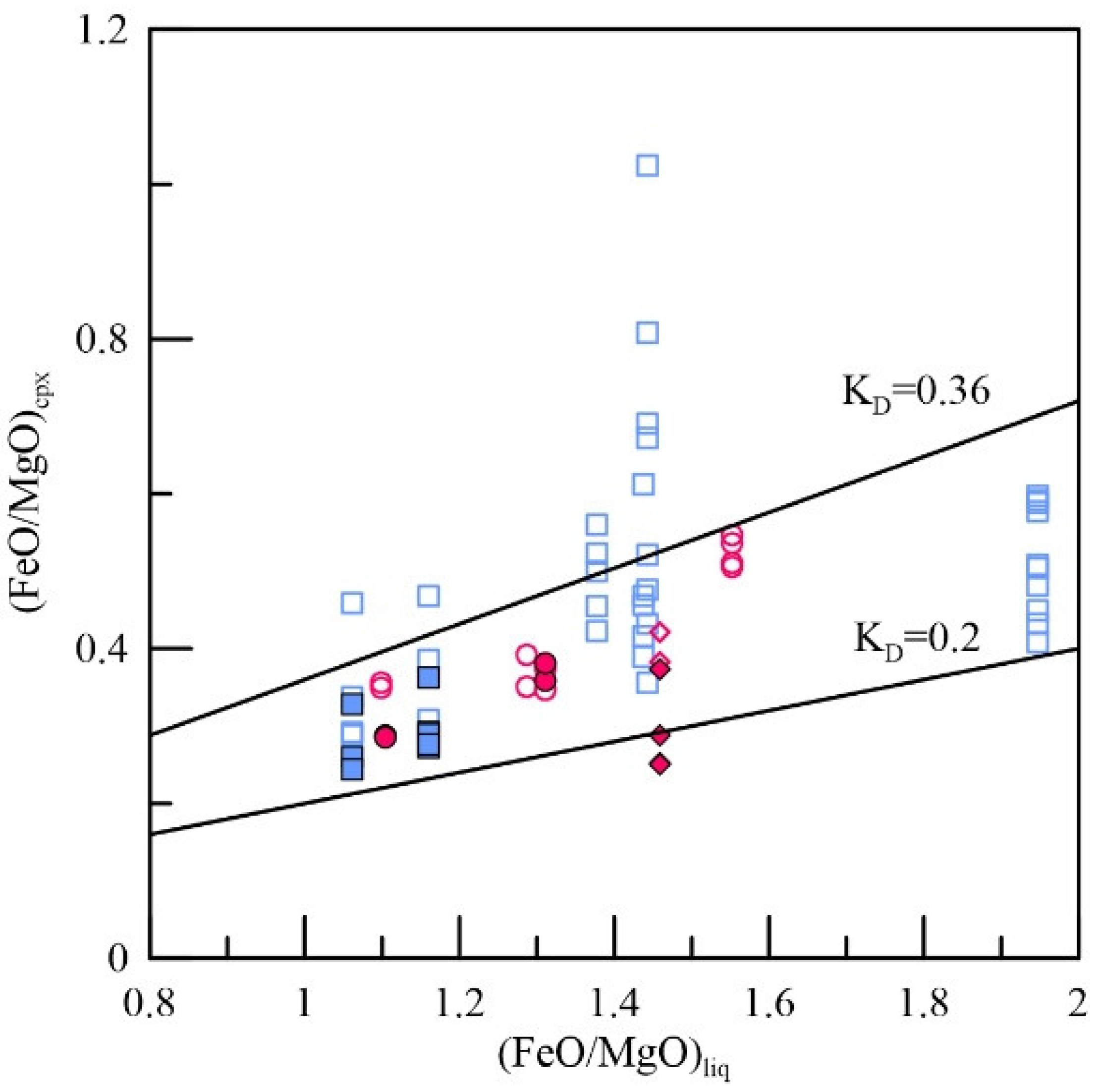


| Plagioclase T/P Calcualtion | Clinopyroxene T/P Calculation | ||||||||||||
|---|---|---|---|---|---|---|---|---|---|---|---|---|---|
| Hole | Occurrence | Plagioclase-Melt Thermometers of Mathez (1973); SD = 34 °C | REE-in-Plagioclase -Clinopyroxene Geothermometer of Sun and Liang (2017) | Clinopyroxene-Liquid Thermobarometer (Eqn. T2 and Eqn. P1 of Putirka et al., 1996); SEE T = ±52 °C; SEE P = ±0.46 Gpa | Clinopyroxene Thermobarometer (Eqn. 32a and Eqn. 32d of Putirka, 2008); SEE T = ±58 °C; SEE P = ±0.31 Gpa | ||||||||
| T (°C) | 1σ | T (°C) | P (GPa) | T1 (°C) | 1σ | P1 (GPa) | 1σ | T2 (°C) | 1σ | P2 (GPa) | 1σ | ||
| U1381A | Phenocryst | 1050–1215 (n = 14) | 55 | 1268 (n = 1) | 0.7 (n = 1) | 1213–1268 (n = 5) | 19 | 0.55–0.97 (n = 5) | 0.15 | 1205–1254 (n = 5) | 16 | 0.46–0.79 (n = 5) | 0.11 |
| Microlite/mircophenocrysts | 866–988 (n = 17) | 40 | 1047 (n = 1) | 1187–1261 (n = 10) | 27 | 0.23–0.93 (n = 10) | 0.23 | 1170–1239 (n = 10) | 22 | 0.02–0.66 (n = 10) | 0.20 | ||
| U1381C | Phenocryst | 1166–1242 (n = 3) | 34 | 1177 (n = 1) | 0.4 (n = 1) | 1174–1187 (n = 2) | 6 | 0.22–0.39 (n = 2) | 0.08 | 1185–1217 (n = 4) | 12 | 0.20–0.35 (n = 4) | 0.06 |
| Microlite/mircophenocrysts | 1021–1032 (n = 3) | 4 | 1145 (n = 1) | 1192–1198 (n = 2) | 3 | 0.43–0.47 (n = 2) | 0.02 | 1191–1195 (n = 2) | 2 | 0.34–0.63 (n = 2) | 0.15 | ||
| U1414A | Phenocryst | 1056–1269 (n = 59) | 40 | 1186–1250 (n = 2) | 0.3–0.4 (n = 2) | 1178–1209 (n = 13) | 9 | 0.12–0.50 (n = 13) | 0.11 | 1181–1215 (n = 13) | 9 | 0.27–0.44 (n = 13) | 0.11 |
| Microlite/mircophenocrysts | 971–1038 (n = 18) | 22 | 1092–1166 (n = 6) | 1162–1208 (n = 25) | 13 | 0.25–0.57 (n = 25) | 0.10 | 1135–1218 (n = 36) | 17 | 0.27–0.70 (n = 36) | 0.12 | ||
Publisher’s Note: MDPI stays neutral with regard to jurisdictional claims in published maps and institutional affiliations. |
© 2021 by the authors. Licensee MDPI, Basel, Switzerland. This article is an open access article distributed under the terms and conditions of the Creative Commons Attribution (CC BY) license (https://creativecommons.org/licenses/by/4.0/).
Share and Cite
Yan, Q.; Ge, Z. Mineral Geochemistry of Basaltic Rocks from IODP Expeditions 334 and 344: Implications for Magmatic Processes of Cocos Ridge Segment Being Subducted Beneath the Middle America Trench. Minerals 2021, 11, 769. https://doi.org/10.3390/min11070769
Yan Q, Ge Z. Mineral Geochemistry of Basaltic Rocks from IODP Expeditions 334 and 344: Implications for Magmatic Processes of Cocos Ridge Segment Being Subducted Beneath the Middle America Trench. Minerals. 2021; 11(7):769. https://doi.org/10.3390/min11070769
Chicago/Turabian StyleYan, Quanshu, and Zhenmin Ge. 2021. "Mineral Geochemistry of Basaltic Rocks from IODP Expeditions 334 and 344: Implications for Magmatic Processes of Cocos Ridge Segment Being Subducted Beneath the Middle America Trench" Minerals 11, no. 7: 769. https://doi.org/10.3390/min11070769
APA StyleYan, Q., & Ge, Z. (2021). Mineral Geochemistry of Basaltic Rocks from IODP Expeditions 334 and 344: Implications for Magmatic Processes of Cocos Ridge Segment Being Subducted Beneath the Middle America Trench. Minerals, 11(7), 769. https://doi.org/10.3390/min11070769





